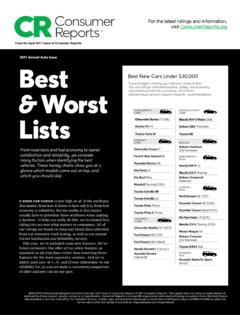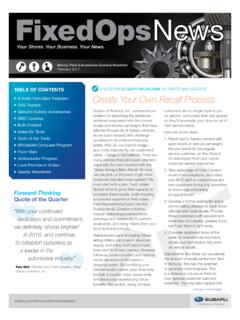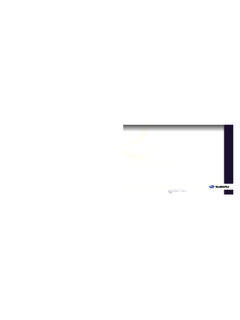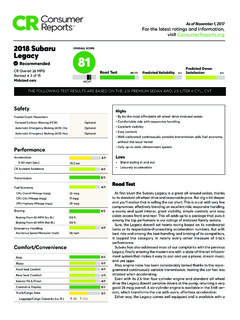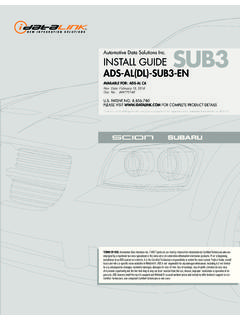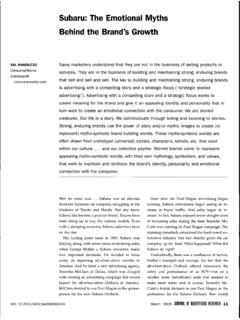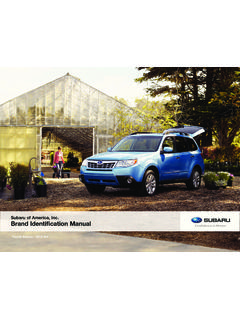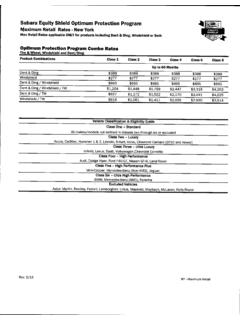Transcription of 2004 LEGACY SERVICE MANUAL QUICK REFERENCE INDEX …
1 FUJI HEAVY INDUSTRIES LEGACY SERVICE MANUALQUICK REFERENCE INDEXWIRING SYSTEM SECTIONThis SERVICE MANUAL has been preparedto provide subaru SERVICE personnelwith the necessary information and datafor the correct maintenance and repairof subaru MANUAL includes the proceduresfor maintenance, disassembling, reas-sembling, inspection and adjustment ofcomponents and diagnostics for guid-ance of experienced peruse and utilize this manualfully to ensure complete repair work forsatisfying our customers by keepingtheir vehicle in optimum replacement of parts duringrepair work is needed, be sure to useSUBARU genuine information, illustration and specifi-cations contained in this MANUAL arebased on the latest product informationavailable at the time of SYSTEMWIWIRING Diagnostic Procedure.
2 Precautions .. Supply Circuit .. Distribution Circuit .. System .. Conditioning System .. Brake System .. Control System .. System .. Communication System .. Meter .. Control System .. Temperature System .. Electrical System .. Gauge System .. Time Dual-range Accessory Power Supply Socket System .. Beam Leveler System .. System .. System .. Entry System .. Light System .. Light and Illumination Light System .. Fog Light System .. System .. Light System .. Fog Light System .. Light System .. Signal Light and Hazard Light System .. Pressure Warning Light System .. Brake / Brake Fluid Level Warning Light Seat Window System .. Fan System .. Window Defogger System .. Control Mirror Belt Warning System .. Heater System .. System .. Dynamics Control System .. Wiper and Washer System.
3 Wiper and Washer Deicer System .. Control System .. Accessory Power Supply Components Wiring Harness .. Wiring Harness (In Engine Compartment) .. Wiring Harness (In Compartment) .. Wiring Harness and Transmission Cord .. Panel Wiring Harness .. Wiring Harness .. Wiring Harness and Trunk Lid Cord .. Wiring Harness and Rear Gate Cord ..373WI-3 WIRING SYSTEMB asic Diagnostic Procedure1. Basic Diagnostic ProcedureA: BASIC PROCEDURES1. GENERAL DESCRIPTIONThe most important purpose of diagnostics is to de-termine which part is malfunctioning quickly, tosave time and IDENTIFICATION OF TROUBLE SYMP-TOMD etermine what the problem is based on the PROBABLE CAUSE OF TROUBLELook at the wiring diagram and check the system scircuit. Then check the switch, relay, fuse, ground, LOCATION AND REPAIR OF TROUBLE1) Using the diagnostics, narrow down the ) If necessary, use a voltmeter, ohmmeter, ) Before replacing certain component parts(switch, relay, etc.
4 , check the power supply,ground, for open wiring harness, poor connectors,etc. If no problem is encountered, check the com-ponent SYSTEM OPERATION CHECKA fter repairing, ensure that the system : BASIC INSPECTION1. VOLTAGE MEASUREMENT1) Using a voltmeter, connect the negative lead to agood ground point or negative battery terminal andthe positive lead to the connector or component ) Contact the positive lead of the voltmeter onconnector (A). The voltmeter will indicate a ) Shift the positive lead to connector (B). The volt-meter will indicate no ) With the test set-up held as it is, turn the switchON. The voltmeter will indicate a voltage and, at thesame time, the light will come ) The circuit is in good order. If a problem such asa light failing to illuminate occurs, use the proce-dures outlined above to track down the CIRCUIT CONTINUITY CHECKS1) Disconnect the battery terminal or connector sothere is no voltage between the check the two leads of an ohmmeter to each ofthe check the circuit has diodes, reverse the two leads andcheck ) Use an ohmmeter to check for diode contacting the negative lead to the diodepositive side and the positive lead to the negativeside, there should be contacting the two leads in reverse, thereshould be no ) Symbol !
5 ! indicates that continuity existsbetween two points or terminals. For example,when a switch position is at 3 , continuity existsamong terminals 1, 3 and 6, as shown in the powerFUSE supplySwitchLightV(A)(B)WI-00095 Continuity No continuityWI-00096 TerminalSwitch PositionOFF1234123456WI-4 WIRING SYSTEMB asic Diagnostic Procedure3. HOW TO DETERMINE AN OPEN CIR-CUIT1) WITH VOLTMETER:An open circuit is determined by measuring thevoltage between respective connectors and groundusing a voltmeter, starting with the connector clos-est to the power supply. The power supply must beturned ON so that current flows in the circuit. If volt-age is not present between a particular connectorand ground, the circuit between that connector andthe previous connector is ) WITH OHMMETER:Disconnect all connectors affected, and check con-tinuity in the wiring between adjacent the ohmmeter indicates infinite , the wiringis HOW TO DETERMINE A SHORT CIR-CUIT1) WITH TEST LIGHT:Connect a test light (rated at approx.
6 3 watts) inplace of the blown fuse and allow current to flowthrough the circuit. Disconnect one connector at atime from the circuit. Starting with the one locatedfarthest from the power supply. If the test light goesout when a connector is disconnected, the wiringbetween that connector and the next connector(farther from the power supply) is ) WITH OHMMETER:Disconnect all affected connectors, and check con-tinuity between each connector and ground. Whenthe ohmmeter indicates continuity between a par-ticular connector and a ground, that connector : HOW TO READ WIRING DIA-GRAMS1. WIRING DIAGRAMThe wiring diagram of each system is illustrated sothat you can understand the path through which theelectric current flows from the and codes are used in the should read as follows: Each connector and its terminal position are indi-cated by a sketch of the connector in a disconnect-ed state which is viewed from the circuit or wiringNo voltage is presentVoltage is presentVVWI-00098 Open circuitContinuity does not wiringTest lampFuse holderWI-00100 Shorted connectorContinuity does not from this direction42413WI-5 WIRING SYSTEMB asic Diagnostic Procedure The number of poles or pins, presence of a lock are indicated in the sketch of each connector.
7 In thesketch, the highest pole number refers to the number of poles which the connector has. For example, thesketch of the connector shown in figure indicates the connector has 9 poles. When one set of connectors is viewed from thefront side, the pole numbers of one connector aresymmetrical to those of the other. When these twoconnectors are connected as a unit, the poleswhich have the same number are joined. WIRING DIAGRAM:The connectors are numbered along with the num-ber of poles, external colors, and mating connec-tions in the accompanying list. The sketch of each connector in the wiring dia-gram usually shows the (A) side of the relationship between the wire color, terminalnumber and connector is described in the :A wire which runs in one direction from a connectorterminal sometimes may have a different color fromthat which runs in the other direction from that used in vehicleSketchSymbolNumber of polesNumbered in order from upperright to lower in order from upperleft to lower rightConnector shown in wiring diagramDouble framesIndicates a lock is the number of a lock is frame123456789WI-00107112233445566WI-001 08 Wire color :BR (No.)
8 1 terminal)RW (No. 3 terminal)i23412 BRRWi2F413(A)WI-6 WIRING SYSTEMB asic Diagnostic Procedure In the wiring diagram, connectors which have noterminal number refer to one-pole types. Sketchesof these connectors are omitted intentionally. The following color codes are used to indicatethe colors of the wires. The wire color code, which consists of two letters(or three letters including Br or Lg), indicates thestandard color (base color of the wire covering) byits first letter and the stripe marking by its secondletter. The table lists the nominal sectional areas andallowable currents of the :When replacing or repairing a wire, be sure to use the same size and type of the wire which was originally : The allowable current in the table indicates thetolerable amperage of each wire at an ambienttemperature of 40!
9 C (104!F). The allowable current changes with ambienttemperature. Also, it changes if a bundle of morethan two wires is codeColorLBlueBBlackYYellowGGreenRRedWWh iteBrBrownLgLight greenGrGrayPPinkOrOrangeSbLight blueVPurpleSASealed (Inner)SBSealed (Outer)WI-00109 BBB15F10WI-00110YL2YG1SB10YL9YG8SA1SB22S A20 YGYLSBSBSAN ominal sec-tional areaNo. of strands/strand diam-eterOutside diameter of wiringAllowable currentAmps/40!C (104!F) (or ) (or ) (or ) (or )21226 (or )28341 (or )38565 (or )51850 color : REFERENCE color :YellowWI-7 WIRING SYSTEMB asic Diagnostic Procedure Each unit is either directly grounded to the bodyor indirectly grounds through a harness ground ter-minal. Different symbols are used in the wiring dia-gram to identify the two grounding systems. The ground points shown in the wiring diagramrefer to the following:NOTE:All wiring harnesses are provided with a groundpoint which should be securely groundIndirect terminalgroundBWI-03791: ABS GROUNDGA: AIRBAG GROUNDGAB: BODY GROUNDGB: ENGINE GROUNDGE: RADIO GROUNDGR: VDC GROUNDGV: REAR DEFOGER GROUNDGDWI-8 WIRING SYSTEMB asic Diagnostic Procedure Relays are classified as normally-open or normally-closed relay has one or more contacts.
10 The wiring diagram shows the relay mode when the en-ergizing circuit is type4-pole6-pole4-pole6-poleNormally-ope n typeNormally-closed typeMixed typeKey to symbols:: Current flows.: Current does not circuit OFFE nergizing circuit ONWI-9 WIRING SYSTEMB asic Diagnostic Procedure Each connector number shown in the wiring dia-gram corresponds to that in the wiring harness. Thelocation of each connector in the actual vehicle isdetermined by reading the first character of theconnector (for example, a F for F8, i for i16, etc.)and the type of wiring harness. The first characterof each connector number corresponds to the areaor system of the harness and cordFFront wiring harnessBBulkhead wiring harnessEEngine wiring harnessTTransmission cordDDoor cord LH & RH, Rear gate cordRear door cord LH & RH, Rear defogger cordiInstrument panel wiring harnessRRear wiring harness,Fuel tank cord,Roof cord, Rear gate cord,Rear defogger ground cord (Sedan model)ABAirbag wiring harnessF23F98F21F58F100F5F27F47F34F19F22 F96WI-00115 Each connector number shown in wiring diagram corresponds to that in the TURN SIGNAL LIGHT LH (UPPER)BG2B1F22 FRONT TURN SIGNAL LIGHT LH (LOWER)BG3B2(GRAY)F3(GRAY)F1912WI-10 WIRING SYSTEMB asic Diagnostic ProcedureD.
